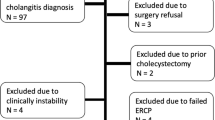Abstract
Background: Laparoscopic common bile duct exploration (LCBDE) is more expensive and time consuming than its conventional counterpart. Therefore, it should only be performed when there is near certainty that stones are present. The purpose of this study was to identify patients who should be spared LCBDE despite an abnormal intraoperative cholangiogram.
Methods: Of 700 consecutive laparoscopic cholecystectomies performed between 1989 and 1994 by a single surgeon (R.J.F.), 41 had abnormal intraoperative cholangiograms (6%). All 41 patients were treated by either immediate CBDE (19) (conventional or laparoscopic) or had postoperative follow-up cholangiograms (22). The patients were retrospectively assigned to one of three groups. Group I patients had a single ``soft'' indicator of choledocholithiasis. Group II patients had one or more of the following: (1) a highly suspicious abnormal intraoperative cholangiogram, (2) two or more ``soft'' indicators of choledocholithiasis, or (3) preoperative clinical findings such as elevated liver function studies or positive preoperative radiological studies. Group III patients had proven choledocholithiasis.
Results: In group I, there were 11 patients, none of whom underwent immediate CBDE. Eight of the 11 (73%) had normal follow-up cholangiograms due to either spontaneous stone passage or a false-positive intraoperative cholangiogram. There were 27 patients in group II; 19 underwent immediate CBDE with 100% stone recovery. The remaining 8 had delayed treatment and in five stones were recovered, while three had normal postoperative cholangiograms suggesting spontaneous stone passage. In group III, all three had negative follow-up cholangiograms despite proven choledocholithiasis. Spontaneous stone passage in this group seemed highly likely.
Conclusions: The finding of a single soft indicator results in a low rate of stone recovery postoperatively, and these patients should not undergo LCBDE. In this series, spontaneous stone passage seemed highly likely in at least 3/22 (14%) and possibly as high as 14/22 (64%).
Similar content being viewed by others
Author information
Authors and Affiliations
Additional information
Received: 29 March 1996/Accepted: 29 July 1996
Rights and permissions
About this article
Cite this article
Ryberg, A., Fitzgibbons, Jr., R., Tseng, A. et al. Abnormal cholangiograms during laparoscopic cholecystectomy. Surg Endosc 11, 456–459 (1997). https://doi.org/10.1007/s004649900389
Published:
Issue Date:
DOI: https://doi.org/10.1007/s004649900389




